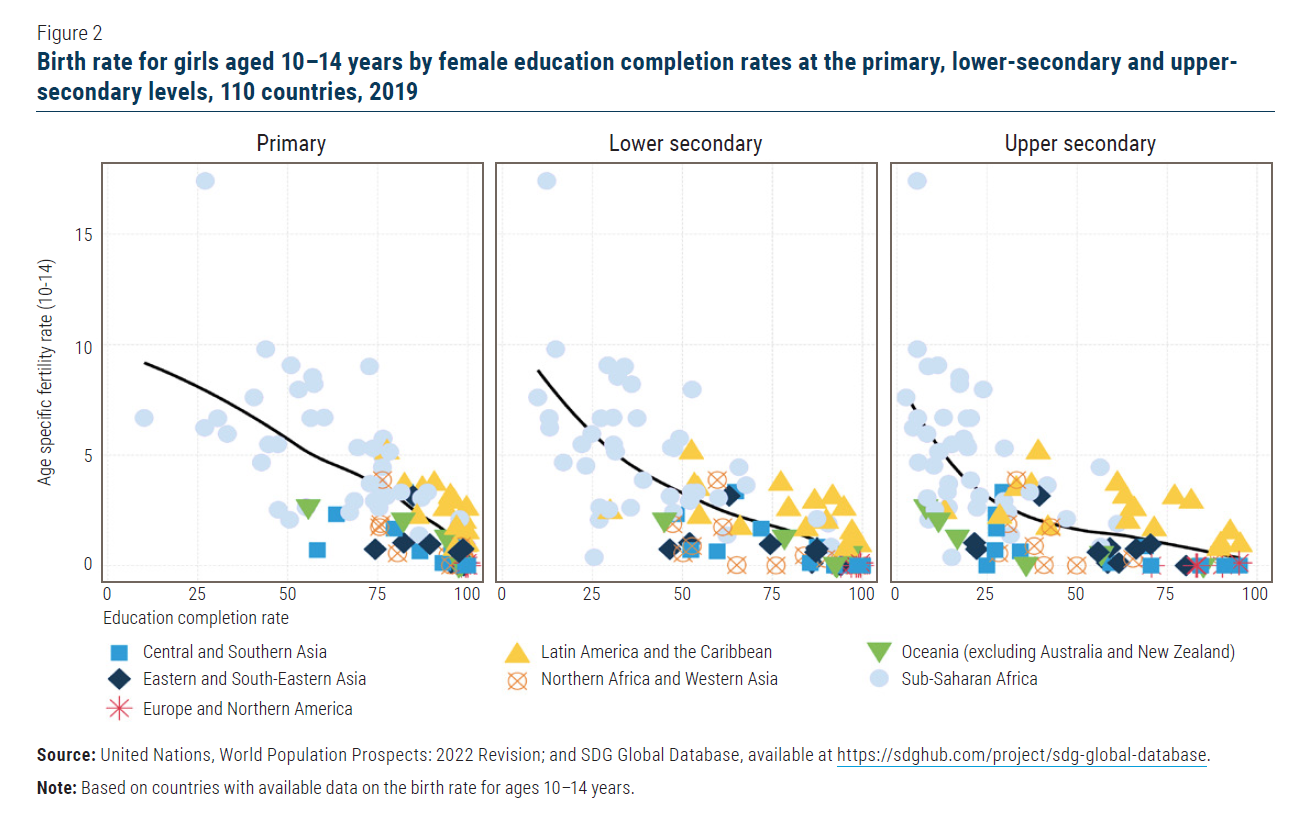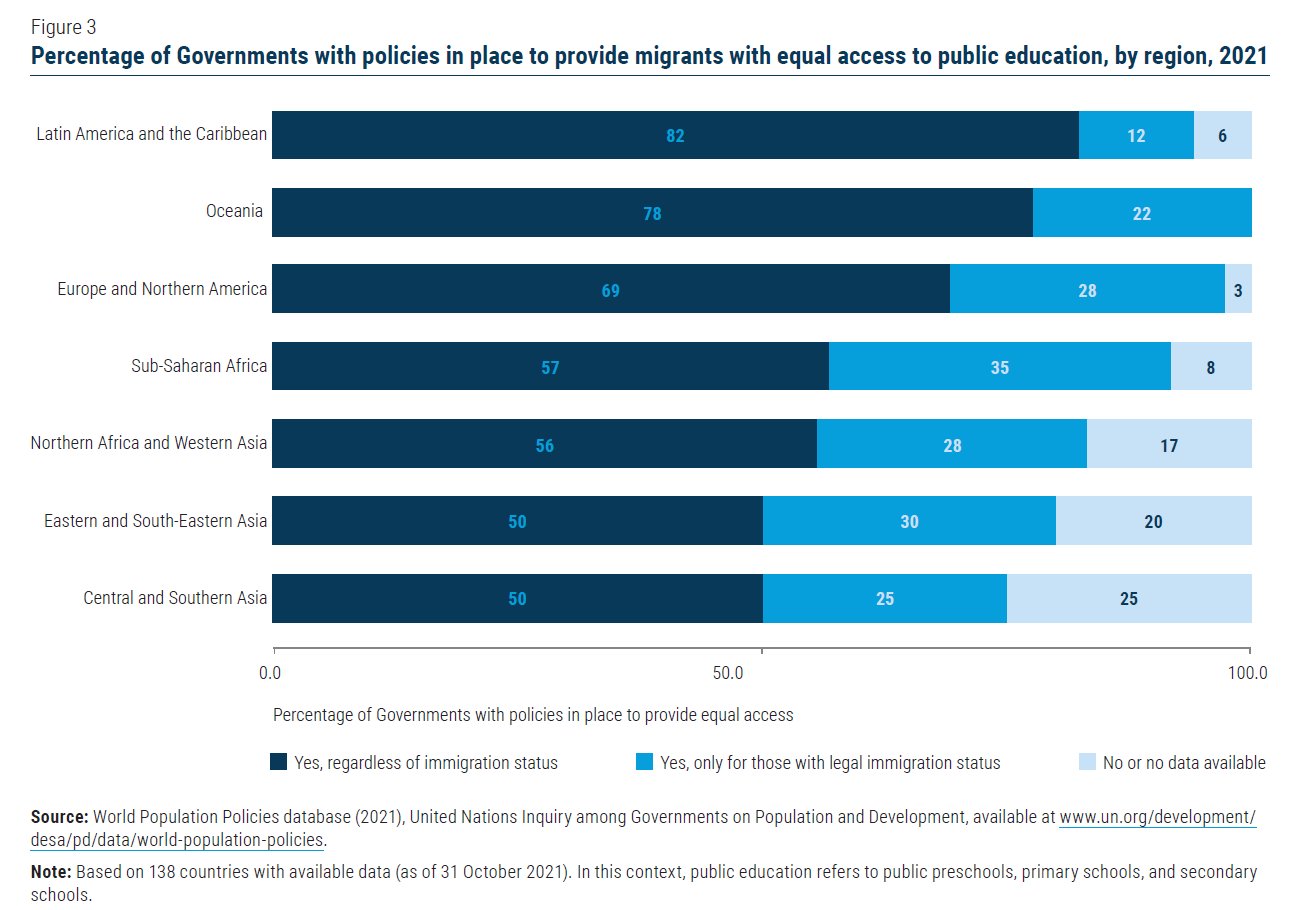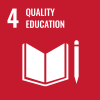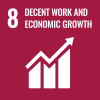
 Introduction
Introduction
Education is a key determinant of levels and trends of fertility, mortality and migration. In turn, coverage and investment in education are influenced by the rate of growth and the age structure of the population. Education and training over the life course are critically important to sustain socioeconomic development, especially in modern economies increasingly driven by innovation and productivity growth. From a macroeconomic perspective, a well-trained and well-educated workforce reinforces the positive impacts of the demographic dividend and tempers the fiscal and economic challenges associated with rapidly ageing populations, while contributing to the achievement of various Sustainable Development Goals and to the realization of the Vision Statement of the Secretary-General on Transforming Education. This policy brief summarizes some policy implications in these and other interlinkages between population, education, and sustainable development.
Population age structure affects education spending, human capital formation and economic growth
Per capita investment in human capital relative to GDP per capita varies widely across countries and tends to be negatively associated with the ratio of young people to the working-age population, illustrating the trade-off between the number of children and per capita investments in human capital. For countries with high fertility and large proportions of children and youth, per capita spending on the human capital of young people is typically less than half as much as in countries with older population age structures.
Global school-age population will peak before 2035 in most regions…
The global school-age population aged 6–11 years (range associated to primary education), is expected to reach an all-time high of 820 million in 2023. It is projected to drop to 774 million in 2032, reach a secondary peak of around 806 million in the early 2050s, and decline continuously thereafter. The projected global trend of the school-age population aged 12–17 years (associated to secondary education) and of those aged 18–23 years (associated to tertiary education) is similar to the projected trend of the school-age population aged 6–11 years, shifted in time by 6 and 12 years, respectively. Thus, the global school-age population aged 12–17 years is projected to reach a peak of nearly 816 million in 2029 and then begin to fall. The school-age population aged 18–23 years (tertiary education) is projected to reach an all-time high of 811 million by 2035 and follow a similar downward trend thereafter.
…with the exception of Africa and Western Asia
Figure 1 shows the projected regional trends by age group. Eastern and South-Eastern Asia are expected to experience the largest decline in the school-age population aged 6–23 years between 2022 and 2050. The second largest decline over this period will take place in Central and Southern Asia. Sub-Saharan Africa will see the largest increase across all the three age segments. 
Fertility decline FACILITATES increased spending per student and improved quality of education
Overall, the global school-age population aged 6–23 years was around 2.3 billion in 2022. It is projected to increase to nearly 2.4 billion in 2030 and oscillate within that range until 2056. However, the proportion of the school-age population aged 6–23 years is projected to decline in all regions in the coming decades, providing an opportunity for many countries to invest in quality education and to increase expenditures per student without necessarily increasing the total spending on the school-age population. This easing of the demographic pressure on educational spending is an important benefit of the fertility decline as part of the demographic transition. A detailed study of the fiscal implications of such changes in 10 countries in Latin America found that projected reductions in the school-age population would permit large increases in spending per student, reaching the average levels of per capita expenditure of OECD countries and facilitating the achievement of universal secondary education with little or no increase in taxes. From the mid-2010 to 2020, public spending on education as a share of GDP had risen gradually for countries in all income groups, but this trend was abruptly interrupted in many countries by the COVID-19 pandemic. Even before the pandemic, there were large inequalities in public spending per capita: in 2020, average spending in sub-Saharan Africa was $254 and South Asia, $358, a small fraction of the average level in Europe and Central Asia, $6,156. Low-income and lower-middle-income countries will need to make an extraordinary effort to recover from learning losses and resume progress towards the universal completion of primary and secondary education by 2030, as prescribed by target 4.1 of the Sustainable Development Goals. International cooperation in this regard is needed now more than ever.
Impact of education on employment and earnings varies by income and demographic context
In high-income and upper-middle-income countries, labour force participation and earnings increase with educational attainment. In these countries, workers with at least upper-secondary education are more likely to find employment and receive higher earnings than those with lower educational levels. The unemployment rate is typically much higher for workers who have not completed upper-secondary education. In such countries, policies to support the completion of secondary education, facilitate school-to-work transitions, and remove barriers to employment can help individuals obtain better-compensated, more productive employment, while benefitting the macroeconomy and alleviating fiscal pressure from unemployment insurance programs. In low-income and lower-middle-income countries, individuals with higher levels of education do not necessarily have higher labour force participation rates. A large share of economic activity and employment in low-income economies is concentrated in the informal sector, agriculture, manufacturing, and trade, where skilled job opportunities are less abundant. Highly skilled workers, namely those with college education or higher, in these countries tend to have higher unemployment rates than those with lower educational levels. These countries need to address the challenge of improving the access to and quality of their education systems while expanding employment opportunities for an increasingly skilled labour force. Such an expansion requires an environment conducive to sustained economic growth (see E/CN.9/2022/2). More highly educated workers generally have better employment opportunities and health and do less physically demanding work than workers with less schooling. At older ages, these factors enhance their ability and willingness to remain in the workforce. In high-income countries and some upper-middle-income countries, people with advanced education are more likely to remain employed past the age of 65 than those with less education, supporting greater autonomy and income security at older ages and alleviating some of the fiscal pressures on public budgets associated with population ageing.
Stark inequalities in access to preschool (early childhood) education require urgent action
Globally, more than 175 million children do not have access to early childhood education. In 2020, nearly one half of pre-primary-age children were not enrolled in an early childhood education programme. Most children who miss out on early childhood education live in low-income countries: in 93 developing countries or areas with data available between 2013 and 2021, 71 per cent of children aged 3–5 years did not attend such a programme; this proportion was nearly 82 per cent for the least developed countries. Deprivation of early education imposes high costs for individuals and for societies; conversely, investments in preschool and childcare yield high returns, of 4 to 16 times the amount spent in such programs.
Despite increased enrolments, further improvements are needed in quality and completion rates
In low-income countries, the number of children enrolled in primary school quadrupled between 1990 and 2020, an expansion driven by population growth and higher rates of school participation. In most regions, the primary net enrolment rate in 2020 was 90 per cent or higher, although in sub-Saharan Africa 80 per cent of primary school-age children were enrolled, up from 61 per cent in 2000. At the lower secondary level, the net enrolment rate was 85 per cent in 2020 globally, compared with 67 per cent at the upper secondary level. During the past three decades, the expansion of tertiary education has been particularly rapid in sub-Saharan Africa, Northern Africa and Western Asia, and Central and Southern Asia, with a nearly six-fold increase in the number of students. Global progress towards the Sustainable Development Goal target of universal completion of primary and secondary education by 2030 has been uneven. In 2020, the completion rate for primary education was 87 per cent globally, but only 63 per cent in sub-Saharan Africa. At the lower- and upper-secondary levels, completion rates worldwide in 2020 were 77 and 58 per cent, respectively. Low-income countries have much lower completion rates: just over half for primary school and slightly more than one third for lower secondary education.
Improved education of women has not erased gender gaps in all regions or in labour markets
The gender gap in school enrolment and attendance has declined globally over the past two decades. In 2020, the global out-of-school rates for primary, lower-secondary and upper-secondary levels of education had a gap of less than 2 per cent each. However, larger gender gaps remain at each level in sub-Saharan Africa and in Northern Africa and Western Asia. Low-income countries are farthest from gender parity in enrolment, as they have made significant yet relatively slow progress over the past 10 years. For lower-secondary education, enrolment rates for young women in low-income countries are still 5 percentage points lower than for young men, while at the upper-secondary level the disadvantage was 9 percentage points. Globally, girls have an advantage regarding completion rates at each education level, with timely completion two percentage points higher for girls than for boys in 2020. However, girls’ completion rates lag in Central and Southern Asia and subSaharan Africa at the upper-secondary level. In some regions, the female advantage in enrolment, educational achievement and school performance has been long-standing. However, those gains have not translated into equivalent success in the labour market, where women remain at a disadvantage in most countries.
Lifelong learning more important now than ever
Demographic changes, along with new technologies and globalization, are transforming the world of work, bringing fresh opportunities and novel challenges for people to access decent jobs and for companies to thrive and adapt. The COVID-19 pandemic disrupted labour markets worldwide and accelerated structural transformations related to remote and flexible work, digitalization and the demand for new types of jobs and skills. These changes are taking place in the context of progressive ageing of the global population. With unprecedented numbers of people surviving to advanced ages, lifelong learning and the re-skilling of workers are more important now than ever. Examples include Finland’s reform of the vocational education and training program, the public-private partnerships in Nigeria to develop digital platforms for youth training, and Costa Rica’s National Institute for Training program on information and communications technologies. Strengthening of intergenerational workforces can alleviate associated fiscal pressures on health and pension systems and contribute to sustained and inclusive economic growth. Significant progress has been made in access to adult learning and education, notably in the participation of women and other disadvantaged and vulnerable groups, such as Indigenous Peoples, rural populations, migrants, older persons, persons with disabilities and prisoners, who often have limited access to learning opportunities. However, significant gaps and challenges remain. Among 159 countries and areas with available data, about 60 per cent reported no improvement in participation by persons with disabilities, migrants or prisoners. In 24 per cent of cases, the participation of rural populations and of older persons had declined.
Staying in school is closely linked to prevention of child marriage and early childbearing
Studies in countries of sub-Saharan Africa, Latin America and the Caribbean, and Europe and Northern America have shown that the earlier girls marry, the less likely they are to be literate or to attend and complete secondary education. Similarly, girls who give birth before the age of 18 have worse educational and labour market outcomes than those who do not. These relationships are also reflected at the population level: across countries, adolescent fertility rates among girls aged 10–14 years (Sustainable Development Goal indicator 3.7.2) are negatively correlated with female education completion rates at the primary, lower-secondary and upper-secondary levels (indicator 4.1.2) (see figure 2).  Child marriage is more common in low- and middle-income countries that do not have a minimum legal age of marriage or do not enforce existing laws, especially in rural areas. Rigorous enforcement of a minimum legal age of marriage brings benefits to both individuals and the society. Multisectoral empowerment programmes that include life skills training, livelihood training, gender awareness training, exposure to future careers and sexual and reproductive health training have been shown to raise school enrolment rates and to lower the risks of pregnancy and early childbearing.
Child marriage is more common in low- and middle-income countries that do not have a minimum legal age of marriage or do not enforce existing laws, especially in rural areas. Rigorous enforcement of a minimum legal age of marriage brings benefits to both individuals and the society. Multisectoral empowerment programmes that include life skills training, livelihood training, gender awareness training, exposure to future careers and sexual and reproductive health training have been shown to raise school enrolment rates and to lower the risks of pregnancy and early childbearing.
Sexuality education brings multiple benefits for human development
Comprehensive sexuality education is a curriculum-based process of teaching and learning about the cognitive, emotional, physical and social aspects of sexuality. It supports achieving development objectives related to health, education and gender equality (Sustainable Development Goals 3, 4 and 5) and tends to reduce adolescent fertility. Education on health, well-being, the human body, sex, and relationships, delivered when an adolescent’s cognitive, emotional, and social development is taking place, yields a range of benefits, including the ability to learn better and lead a healthier and happier life. Sexuality education can help to reduce early or unintended pregnancies, enhance gender-equitable attitudes and reduce school dropout rates. It also contributes to delayed sexual initiation and reduced incidence of HIV and other sexually transmitted infections. When delivered in conjunction with reproductive health care, including contraceptive services, comprehensive sexuality education is a core component of effective pregnancy prevention programmes among adolescents and young people. Schools are important sites for delivering such education because trained teachers can impart age-appropriate knowledge, attitudes and skills and can support learners and their families in accessing health and social protection services. 
Access to education and recognition of credentials are key to migrant integration and success
Immigrants and their children, sometimes even those born in the host country, face various barriers in accessing quality education and learning opportunities. They are less likely to be enrolled in early childhood education, which can negatively impact their academic performance and lifetime educational attainment. Overcoming these barriers is critical for improving the educational outcomes of migrant children and promoting their integration into host societies. The proportion of Governments giving migrants access to public education varies across regions. Countries in Central and Southern Asia and in Eastern and South-Eastern Asia had the lowest proportion of Governments (50 per cent each) reporting that they provided equal access to public education for all migrants, regardless of immigration status. Latin America and the Caribbean (82 per cent) and Oceania (78 per cent) had the highest proportions of Governments reporting such policies (see figure 3). For countries of origin, the emigration of individuals with high levels of human capital and skills can have negative consequences in terms of productivity, provision of services and tax revenues, a phenomenon known as “brain drain”. From the perspective of destination countries, immigration often brings a net gain in the human capital and skills of the average worker. In many OECD countries, immigrants are more likely to have attended or completed tertiary education than the native-born population. Host countries benefit from the influx of highly skilled migrants who often boost innovation, particularly in science and technology. But “brain waste” occurs when well-educated, highly skilled migrants are employed in occupations that require lower skill levels, resulting in a loss of income and a waste of human capital. In this regard, the Global Compact for Safe, Orderly and Regular Migration called for Governments to facilitate the mutual recognition of the skills, qualifications and competencies of migrant workers at all skill levels and to promote demand-driven skills development to optimize the employability of migrants in formal labour markets in countries of destination and in countries of origin upon return (see General Assembly resolution 73/195, annex).
 Welcome to the United Nations
Welcome to the United Nations


